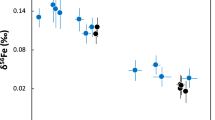Abstract
Radiation-induced centres of Al, Ti, Ge and E′ occurring in the natural quartz of various geological materials were discussed a decade ago by McMorris1,2; but it is only recently that the peroxy centre for natural flint3, the E′ centre for quartz from a fault4 and the Ge centre for quartz from welded tuff5 have been used for electron spin resonance (ESR) dating. The ages of volcanic ash or lava have been obtained by thermoluraieescence (TL) dating using fine (2–11-µm) volcanic glass6 or plagioclase feldspar7 respectively. However, ESR dating of volcanic ash has proved extremely difficult because signal intensities of radiation-induced centres measured at room temperature are weak compared with the interfering signals from paramagnetic impurities such as Fe3+ and Mn2+. Here we have used a signal from a quartz aluminium centre, measured at 77 K, where it is several orders of magnitude greater than those of the E′ or Ge centres at room temperature. The aluminium-centre ESR signal can also be observed in plagioclase feldspar and volcanic glass, allowing the age of the volcanic debris to be determined using any of the three mineral compounds.
This is a preview of subscription content, access via your institution
Access options
Subscribe to this journal
Receive 51 print issues and online access
$199.00 per year
only $3.90 per issue
Buy this article
- Purchase on Springer Link
- Instant access to full article PDF
Prices may be subject to local taxes which are calculated during checkout
Similar content being viewed by others
References
McMorris, D. W. Nature 222, 870–781 (1969).
McMorris, D. W. Nature 226, 146–148 (1970).
Garrison, E. G., Rowlett, R. M., Cowan, D. L. & Holroyd, L. V. Nature 290, 44–45 (1981).
Ikeya, M., Miki, T. & Tanaka, K. Science 215, 1392–1393 (1982).
Shimokawa, K., Imai, N. & Hirota, M. Isotope Geosci. 2, 365–373 (1984).
Berger, G. W. & Huntley, D. J. PACT 2, 581–592 (1983).
Guérin, G. & Valladas, G. Nature 286, 697–699 (1989).
Emura, S. Bunseki Kagaku 19, 637–642 (1970).
Pollock, E. N. Analyt. chim. Acta 88, 399–401 (1977).
Terashima, S. Bull. geol. Surv. Jap. 30, 37–43 (1979).
Schnadt, R. & Räuber, A. Solid State Commun. 9, 159–161 (1971).
Bell, W. T. Archaeometry 21, 243–245 (1979).
Hennig, G. J. & Grün, R. Quat. Sci. Rev. 2, 157–238 (1983).
Tamanyu, S. & Suto, S. Bull. geol. Surv. Jap. 29, 159–161 (1978).
Machida, H. & Arai, F. Quat. Res. 22, 133–148 (1983).
Suzuki, M. & Sugihara, S. Abstr. A. Meet. Jap. Ass. Quat. Res., 69 (1983).
Mizuno, K., Yamazaki, H. & Shimokawa, K. Abstr. A. Meet. Jap. Ass. Quat. Res, 43 (1983).
Author information
Authors and Affiliations
Rights and permissions
About this article
Cite this article
Imai, N., Shimokawa, K. & Hirota, M. ESR dating of volcanic ash. Nature 314, 81–83 (1985). https://doi.org/10.1038/314081a0
Received:
Accepted:
Issue Date:
DOI: https://doi.org/10.1038/314081a0
This article is cited by
-
Various Recombination Kinetics of Al Centers in Quartz from the Elbrus Volcano and the Eldzhurtinsky Granite Rocks
Applied Magnetic Resonance (2007)
-
ESR and ESR microscopy in geosciences and radiation dosimetry
Applied Magnetic Resonance (1994)
-
Dating volcanic ash by ESR
Nature (1986)
-
Dating volcanic ash by ESR (reply)
Nature (1986)
Comments
By submitting a comment you agree to abide by our Terms and Community Guidelines. If you find something abusive or that does not comply with our terms or guidelines please flag it as inappropriate.



